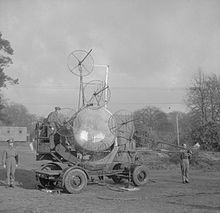76th Searchlight Regiment, Royal Artillery
| 76th Searchlight Regiment, RA | |
|---|---|
 Royal Artillery cap badge | |
| Active | 20 May 1940–23 September 1944 |
| Branch | |
| Type | Searchlight Regiment |
| Role | Air Defence |
| Engagements | Battle of Britain The Blitz |
The 76th Searchlight Regiment, Royal Artillery (76th S/L Rgt) was a British Army air defence unit during World War II. It was engaged during the Battle of Britain and The Blitz, defending Royal Air Force airfields and the towns of southern England.
Origin
76th was the first
However, these plans were immediately changed: the CO was posted away within two weeks, and 476th and 477th S/L Btys were disbanded in June and July, the personnel of 477th being posted to help reform 1st S/L Rgt after its return from Dunkirk. Two new batteries were formed: 492nd S/L Bty from 217th SLTR, and 493rd S/L Bty from 222nd SLTR at Yeovil. Then in August 475 S/L Bty was exchanged with 485 S/L Bty from the reforming 2nd S/L Rgt, giving 76th S/L Rgt the following composition from 24 July:[1][5]
- RHQ
- 474th S/L Bty
- 485th S/L Bty
- 492nd S/L Bty
- 493rd S/L Bty
Of these, 474th S/L Bty had already seen service defending
The Blitz

During the autumn, as the night-bombing 'Blitz' against British cities got under way, there was some movement among the regiment's detachments. While 474th and 485th Btys deployed at the standard 3000-yard intervals, 493rd Bty was in four six-light clusters and 485th was in three-light clusters. The cluster system was an attempt to improve the chances of picking up enemy bombers and keeping them illuminated for engagement by AA guns or Night fighters. Eventually, one light in each cluster was to be equipped with searchlight control (SLC) radar and act as 'master light', but the radar equipment was still in short supply. 485th and 493rd Btys received their first Gun-Laying Radar Mk I sets in December and became operational at the end of the year. The regiment was fully deployed in three-light clusters by mid-January[1][7][8]
In November 1940 76th S/L Rgt came under 64th AA Bde in 8th AA Division, both being new formations created in the rapidly-expanding Anti-Aircraft Command. The brigade's prime responsibility was airfield defence in South West England.[1][4][9][10][11][12]
In January 1941 474th Battery moved to
Mid-war

After the Blitz ended in May 1941, the regiment continued its home defence role in AA Command. In September it began to receive its first purpose-built SLC radar (AA Radar No 2) in sufficient numbers to allow the sites to be 'declustered' into single-light sites spaced at 6000-yard intervals in a 'Killer Belt' cooperating with night-fighters.[1][14][15]
In November 1941, the regiment was relieved by 2nd S/L Rgt and redeployed to
By May 1942 the regiment had transferred to 60th AA Bde, and then before October 1942 to 69th AA Bde, both in 8th AA Division in SW England.[16][17]
At the end of September 1942 the AA Divisions were disbanded, being replaced by new AA Groups more closely aligned with the Groups of Fighter Command. 76th Searchlight Regiment remained in 69th AA Bde, now part of 3 AA Group, coinciding with No. 10 Group RAF covering SW England and South Wales.[18]
Break-up
- See main article 474th Searchlight Battery, Royal Artillery
On 20 February 1943, 474th S/L Bty ceased to be part of 76th S/L Rgt and became an independent unit training for a mobile role in Operation Overlord, the planned invasion of continental Europe.[5][18][19]
The rest of 76th S/L Rgt remained in 69th AA Bde until Spring 1944 when it transferred back to 64th AA Bde.[18][20][21]
As the threat from the
Notes
- ^ a b c d e f g h 76 S/L Rgt War Diary, 1940–41, The National Archives (TNA), Kew file WO 166/3096.
- ^ a b 474 S/L Bty War Diary, 1940–41,TNA file WO 166/3322.
- ^ a b Farndale, Annex M.
- ^ a b c 76 S/L Rgt at RA 39–45.
- ^ a b c d Frederick, pp. 860–1, 873.
- ^ Routledge, Table LVIII, p. 376.
- ^ Routledge, p. 393.
- ^ a b Sainsbury, p. 137.
- ^ Farndale, AnnexD.
- ^ Routledge, Table LXV, p. 396.
- ^ 8 AA Division at British Military History.
- ^ Order of Battle of Non-Field Force Units in the United Kingdom, Part 27: AA Command, 12 May 1941, TNA file WO 212/79.
- ^ Routledge, p. 98.
- ^ Routledge, pp. 99 & 399.
- ^ Sainsbury, p. 140.
- ^ Order of Battle of Non-Field Force Units in the United Kingdom, Part 27: AA Command, 14 May 1942, TNA file WO 212/81.
- ^ Order of Battle of Non-Field Force Units in the United Kingdom, Part 27: AA Command, 1 October 1942, TNA file WO 212/82.
- ^ a b c Order of Battle of Non-Field Force Units in the United Kingdom, Part 27: AA Command, 13 March 1943, TNA file WO 212/83.
- ^ 474 (Ind) S/L Bty War Diary, 1943, TNA file WO 166/11557.
- ^ Order of Battle of AA Command, 1 August 1943, TNA file WO 212/84.
- ^ Order of Battle of AA Command, 27 April 1944, TNA file WO 212/85.
- ^ Routledge, pp. 420–1.
References
- Gen Sir ISBN 1-85753-080-2.
- J.B.M. Frederick, Lineage Book of British Land Forces 1660–1978, Vol II, Wakefield: Microform Academic, 1984, ISBN 1-85117-009-X.
- Brig N.W. Routledge, History of the Royal Regiment of Artillery: Anti-Aircraft Artillery 1914–55, London: Royal Artillery Institution/Brassey's, 1994, ISBN 1-85753-099-3.
- Col J.D. Sainsbury, The Hertfordshire Yeomanry Regiments, Royal Artillery, Part 2: The Heavy Anti-Aircraft Regiment 1938–1945 and the Searchlight Battery 1937–1945; Part 3: The Post-war Units 1947–2002, Welwyn: Hertfordshire Yeomanry and Artillery Trust/Hart Books, 2003, ISBN 0-948527-06-4.
External sources
